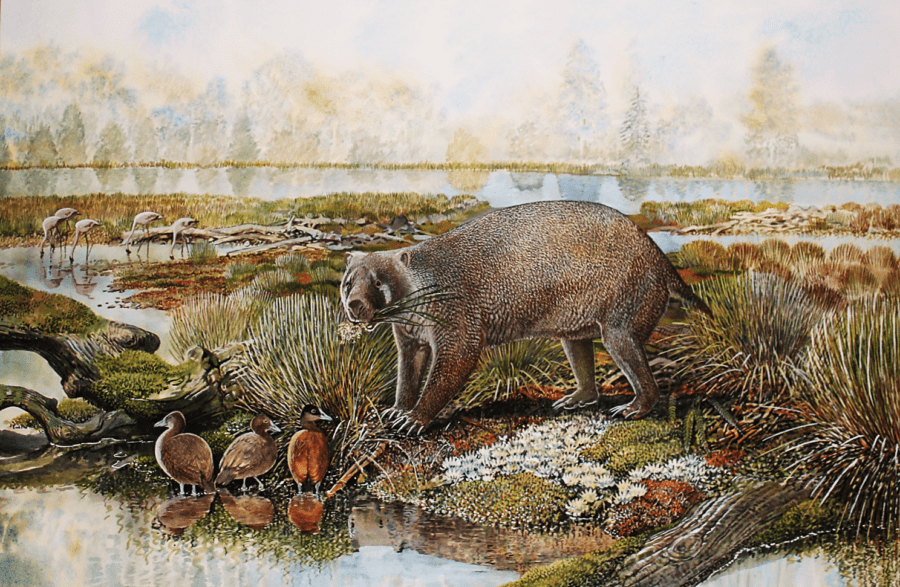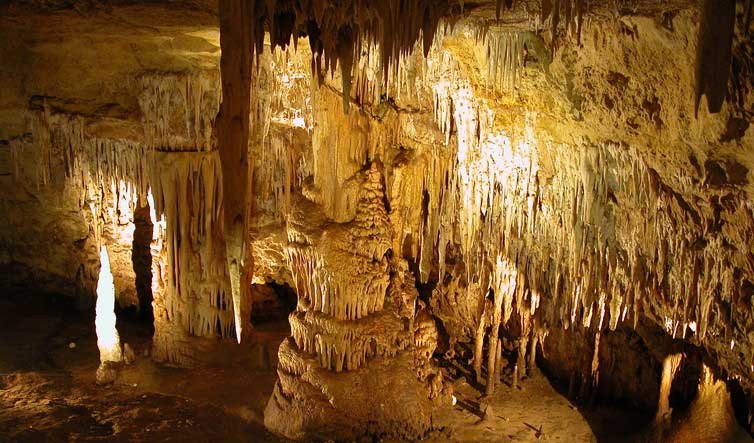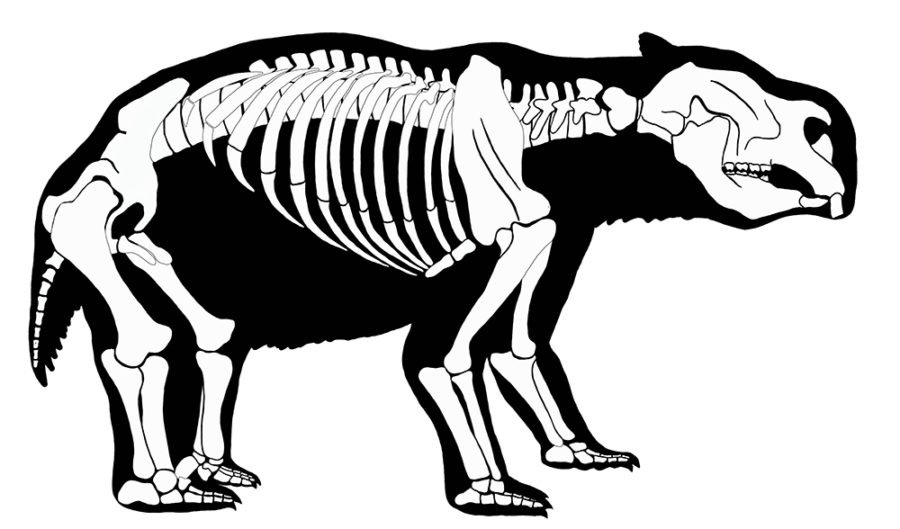Giant marsupial ‘Mukupirna’ discovered half a century after it was first dug up

IN 1973, well-known Australian palaeontologist Mike Archer was part of an international exploration team led by Dick Tedford from the American Museum of Natural History (ANHM) to Lake Pinpa, located on the eastern side of the Flinders Ranges in South Australia, following reports of various kinds of fossils sprawled cross the lake’s surface.
What they first found were what Mike describes as “blobs” of bone material, thought to be the excrement of an ancient animal that existed 25 million years ago. “We found all sorts of things in these piles: the teeth of lungfish, carnivorous marsupials and ringtail possums, flamingo bones, turtle fragments, crocodile teeth and most bizarrely, the teeth of a new kind of freshwater dolphin,” Mike recalls.
Favourable weather conditions the previous year had also exposed more complete skeletal remains on the floor of the lake. “The sands and salts that usually cover the surface had been blown away so that the actual surface – the clay surface – which itself was 25 million years old, had been exposed. Hence, in addition to the curious ‘blobs’, large skeletons were periodically poking up through the surface which made us realise this wasn’t just about finding small fragments, we were going to get big animals.”
Using a method Mike describes as “acupuncturing Mother Earth’s skin”, a narrow metal rod was carefully pushed down through the clay surface. If it encountered something hard, we dug down and found in most cases that these were fossil skeletons. When this happened, the clay around the fossil was quarried and the pedestal of clay containing the fossil was enclosed in plaster. After this plaster had hardened as a protective shell, the specimen was ready to be shipped off to the AMNH. “For subsurface specimens discovered this way, we didn’t end up seeing what they were like until years later. The skeleton of our new beast was originally one of these mysterious finds.”
Mukupirna, an ancient wombat-like marsupial
Mukupirna – meaning “big bones” in the Dieri and Malyangapa Aboriginal languages – roamed the Australian continent 25 million years ago, when central Australia, rather than being dominantly covered in grasses, was marked by what Mike describes as “scrubby rainforest”.
This enormous, ancient marsupial had a similar frame to that of a wombat, but its size and teeth differ greatly from that of all known ancient marsupials including all known wombats, which is why it has been put in an all-new family, the Mukupirnidae. “If you lifted up the lips of a live one and had a good look at the teeth, you’d quickly realise you were not looking at a wombat,” Mike says. “It’s also four times larger than any living wombat, so we’re talking seriously big here.”
Unlike modern wombats, Mukupirna wasn’t a burrower. “We’re quite certain you wouldn’t see it burrow, but it was probably using very powerful forelimbs for what we call ‘scratch digging’, which means it was able to dig holes in the ground; an indication, combined with what we understand about the teeth, that it may have been eating some relatively soft subsurface plant material as well as leaves on the surface.”
These differences mean the Mukupirnidae family may be more closely related to wombats than koalas, although it is distantly related to both. “Today, the only groups of this kind of marsupial that survive are the wombats and koalas, they’re each other’s closest relatives. But if you go back in time you find there are an enormous number of groups that were much closer to wombats than wombats are to koalas.”
Griffith University’s Associate Professor Julien Louys, who co-authored the study, says “the description of this new family adds a huge new piece to the puzzle about the diversity of ancient, and often seriously strange marsupials that preceded those that rule the continent today”.
Curious circumstances
The fossils belonging to Mukupirna were described in a paper published in Scientific Reports today, almost 50 years after they were first exhumed from Lake Pinpa by Mike and the other members of the 1973 expedition.
Julien was a former PhD student of Mike’s and is responsible for the renewed interest in the long-forgotten remains of Mukupirna. However, that these particular remains were unique had been known for some time.
In the 1990s, Dick Tedford travelled to Sydney to meet with Mike at the University of New South Wales. He had with him a row of fossil teeth from this specimen. After they compared these to other somewhat similar forms turning up in the Riversleigh World Heritage fossil deposits in Queensland, he and Mike decided to describe the new material jointly.
Unfortunately, Dick died before this was possible. “I had no intention of rattling the doors of the AMNH and so I just let it go,” Mike says. That was until Julien began work on the fossils while working at the AMNH. He had coopted Robin Beck and Pip Brewer, two other former students at UNSW, and soon thereafter they invited Mike to join in the research. “Since 1973, it has taken a long while to get it out in front of the public because of these curious circumstances but finally it’s time has come!”
Central Australian fossil deposits
Mike is one of the leading paleontologists unearthing the wonders of the World Heritage-listed Riversleigh Area of northwestern Queensland, which has revealed some of the richest fossil deposits in Australia. The fossils there are protected by having been encased with calcium carbonate “so even the most delicate things like bat skulls are perfectly preserved right down to the tiniest detail,” Mike says.
Lake Pinpa fossils, in contrast, are not quite as well preserved and hence considerably more difficult to recover and reconstruct. “Many of the fossils from clay deposits in central Australia look like they’ve been run over by a steamroller. In the case of the Mukupirna, the skull is in hundreds of tiny pieces, but fortunately the teeth and some of the limb bones survived the forces that fragmented the skull.”
To build our understanding of these ancient creatures, what’s unearthed at Riversleigh is often compared to other fossil sites, such as Lake Pinpa. What’s odd about Mukupirna, however, is that it represents a group that is yet to turn up at Riversleigh. “In most cases, the kinds of animals that turn up in central Australian fossil deposits prove to be at least close relatives of those found at Riversleigh. We have some candidates for relatives of Mukupirna, but are yet to determine just how closely related they actually are.”
So what happened to Mukupirna?
It’s likely Mukupirna was a victim of climate change. Around 23 million years ago, Australia transitioned from a somewhat cooler environment into a full-on greenhouse phase. “That shift into a greenhouse state would probably have been what undid Mukupirna’s ability to survive,” Mike says. “It may have been specialised on particular plants that couldn’t deal with a wetter, more dense forest. It would have been a case of being too specialised and not sufficiently flexible to adapt to a changing environment.”
Ancient Australia even weirder than modern Australia, and there’s more to be found
The discovery of Mukupirna consolidates Australia’s already well-established claim to having some of the most unique creatures in the world, living or extinct.
“The rest of the world already thinks of Australia as a weird place,” Mike says. “Our koalas, kangaroos, possums and platypuses don’t occur anywhere else. In part this is because the other continents have had a long history of exchanging the same groups such as camels, lions and elephants. But because Australia became an island about 50 million years ago, most of its creatures evolved more or less in isolation to become the world’s most distinctive assemblage of animals.”.
“When you dip below the surface of the modern world into Australia’s fossil record, besides the ancestors for the modern groups we already know about, but still other bizarre groups, like Mukupirna, that evolved here but didn’t manage to produce descendants that survived into the modern world.”
Mike’s confident that more palaeontological treasures lie beneath Australia’s surface, ready to be discovered. “The rate at which we’re discovering things at Riversleigh certainly has been higher than anywhere else, but palaeontologists across the continent are making equally exciting discoveries in all states of Australia. If the present accelerating rate of making new discoveries continues, exciting beasts will be turning up for many centuries to come.




